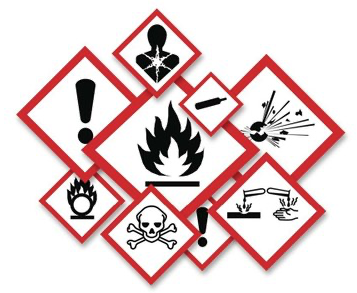The SF State Hazard Communication (HazCom) program helps ensure employees are aware of the hazards of chemicals used in their workplace. These hazardous chemicals or substances include, but are not limited to, chemicals, fuels, paints, inks, glues, lubricants, cleaning agents, and compressed gases.

Hazard Pictograms: From the Globally Harmonized System of Classification and Labeling of Chemicals, also known as GHS.
California Occupational Safety and Health Administration (Cal/OSHA) requires employers to inform employees about hazards associated with hazardous chemicals that are present in the workplace. Hazard Communication is also known as the Employee Right-To-Know law. Departments who handle, use or store hazardous chemicals generally fall under one of two categories:
Are subject to the requirements of Title 8, California Code of Regulations (CCR), section 5191, “Occupational Exposure to Hazardous Chemical in Laboratories” and are covered under the Chemical Hygiene Plan (CHP) requirements.
- This allows some flexibility in how labs can communicate the chemical hazards of hazardous materials containers as long as the method is effective.
- The requirements for a chemical inventory, access to Safety Data Sheets, and manufacturer container labeling are the same.
Are subject to requirements of Title 8, CCR section 5194, “Hazard Communication” and are covered under the Hazard Communication Program requirements.
Employees who enter labs for cleaning or servicing equipment are not "lab" workers so HazCom applies.
Program Elements
- Written program available to employees
- Chemical inventory
- Safety Data Sheets (SDS)
- Labeling and GHS Pictograms
- Training
- Recordkeeping
Quick Links
- SFSU Hazard Communication Written Program (pdf)
- SFSU Chemical Hygiene Plan page
- GHS Hazard Pictogram Guide
- Know your Hazard Symbols: Pictograms (Princeton University)
- Safety Data Sheets (SDS) page
Credit: Thank you to our friends at UC Davis for their HazCom program information that helped us put this web page together.
HazCom Requirements
Under the California Labor Code and the California Occupational Safety and Health Act, all employers in California are legally obligated to establish a hazard communication program.The SF State Hazard Communication Program (HazCom) applies to industrial and commercial workplaces, and activities such as shops, custodial, craft centers, theaters and art studios. The program requires employees to do the following:
- Maintain a hazardous chemical inventory
- Maintain and have access to safety data sheets (formerly called material safety data sheets)
- Understand hazards associated with chemicals they work with through labeling and other forms of warning. Understand GHS hazard pictograms.
- Receive safety training and other information to minimize the risks associated with the hazardous chemicals used in the work area
- Develop, implement and maintain a written HazCom program
SF State assigns the "Hazard Communication Basics" training to all employees. This training covers the employee Right-To-Know law, which includes instructions on how to read and understand chemical labels and Safety Data Sheets so employees can determine if everyday materials they encounter on the job pose a risk.
According to OSHA, workers have the right to know what hazards are present in the workplace and how to protect themselves.
For example, an office employee cleans their desk surface weekly with a cleaning product purchased by the employer from a grocery store and is available for employee use. Is HazCom training required for that employee?
The Practical Answer
HazCom training is not required for incidental use of a consumer product used in a consumer manner but general awareness training for all employees of the hazardous material identification system would be considered wise and a ‘best practice’ for all employers.
Why? Because in the event of an injury to an employee caused by substances in the workplace, it could be deemed a violation that an employer provided a product but not information of its hazardous nature.
- Hazard Communication is also known as the Employee Right-To-Know law.
- Employees have a right to information about hazardous substances in their workplace.
Even office workers and lecturers should know that all chemical containers must be labeled and are able to understand the hazard and safety precautions written on the labels.
- Many buildings at the university have areas where hazardous materials are used or stored. Understanding the hazard information on container labels may be helpful in an emergency situation.
- Chemicals, products with hazardous materials and some consumer products use the Globally Harmonized System (GHS) pictograms and language on container labels.
(source: Bender Insurance Solutions, "Do Office Employees Need Training for GHS (Globally Harmonized System of Identification of Hazardous Substances)?
Hazard Communication Basics is the online training assigned to all employees. It reviews labeling requirements, GHS (Globally Harmonized System) hazard pictograms, and how to read chemical product labels and safety data sheets.
- Assigned to new hires
- CSU requires refresher training every three years
For those employees who work with or around hazardous materials on a regular basis, additional job or work-specific training on the chemical hazards of these materials is required. This is usually done or arranged by the department, manager or supervisor as it is specific to each job or workplace.
- Initial training before starting work with hazardous substances
- When a new hazard is introduced. For example, a flammable substance is introduced to a workplace that never had flammables before.
This additional training is typically not required for office or computer workers who only use or work around consumer products used as intended.